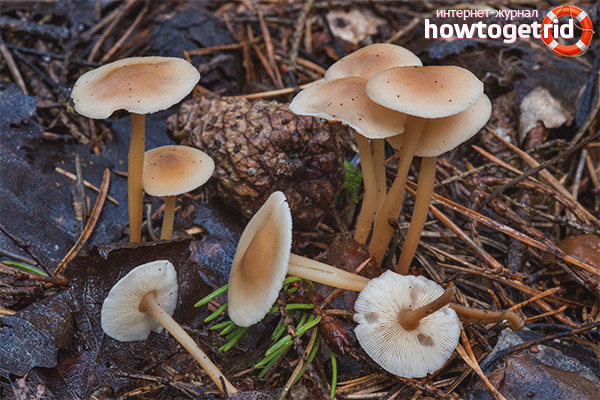The content of the article
According to the variety of mushrooms, the forest-loving colibia is referred to the non-fungal family. In the people, this variety of mushrooms is usually called the open air spring because of its external resemblance to honey agarics. However, often such confusion occurs by mistake and inexperience of the mushroom pickers themselves. In fact, collibia is considered a parasitic fungus and has nothing to do with honey mushrooms.
According to the classification of edibility, the representative of the mushroom kingdom - colibia is usually classified as conditionally edible mushrooms of the fourth category. After the collibia has appeared in a basket of a mushroom picker, it should be given to culinary processing. The mushroom must first be boiled and the resulting broth drained, only after that it can be used as food.
Characteristic of a Collibia forest-loving
Young collibia mushrooms have a hat that resembles a sphere in appearance. As the fungus develops, its hat acquires an open, flat shape with transparent margins. In diameter, the cap of the mushroom reaches about 2-6 cm. Young collibia fungi have some similarities with apples that fell on fallen leaves in the forest.
The core of the fungus has a brown, light yellow or sometimes white flesh. The color of the pulp directly depends on the conditions and the environment in which the mushroom ripens. If you look through the thin and transparent edges of the hat, you can see plates that are loosely attached to the base of the mushroom. The older the mushroom ripens, the more it will be covered with reddish spots that appear on the inside of the fruit. Transparent and thin edges begin to tear.
The mushroom leg has a thin base, inside it is hollow and twists a little in length, at the end it thickens a little. The structure of the mushroom leg has a fibrous and cartilaginous surface. The hat and foot are the same color. The mushroom leg can reach 2 or 6 cm in length.
Is collibia edible forest-loving?
Collibia is an edible mushroom, so it can be used in recipes. However, due to its low taste, it is not in special demand among mushroom pickers. In addition, if a person has digestive disorders, then this mushroom should not be used as food. Collibia can cause intestinal and stomach ailments and pain.
Among cooks, collibia is also not very popular, since inside the mushroom there is very little soft core and pulp for cooking. In addition, the mushroom does not have a strong aroma and taste. The aroma of collibia can even, on the contrary, give the dishes an unpleasant odor with an admixture of mold and rot.
Colibia growth medium
The forest is considered the habitat of the fungus, which is why the collibia is called forest-loving. You will not meet her in the fields or in the gardens. A collibia can be found in deciduous and coniferous thickets of the forest. Most often, this species of mushroom family grows in the European part of Russia.
The first mushrooms germinate in May and give entry until the end of autumn.You can find a collibia among the foliage, in a humid lowland, in a decaying fallen tree or on a stump. Thanks to such places, the fungus survives and receives the substances and water it needs. Also, the fungus can grow on the surface of a tree trunk.
Doubles in the kingdom of mushrooms
The collibia has a forest-loving and close relatives. Oil colibia is considered to be such a relative mushroom; it also refers to conditionally edible varieties of mushrooms. The mushroom has a brown or red-brown color. Also, the forest-loving collibia can often be confused with some other varieties of the collibia family, which, moreover, can be very poisonous and life-threatening. However, poisonous species are quite rare. To find the difference between a poisonous and an edible mushroom can only mushroom pickers with extensive experience.
Video: Collibia forest-loving (Gymnopus dryophilus)











Submit